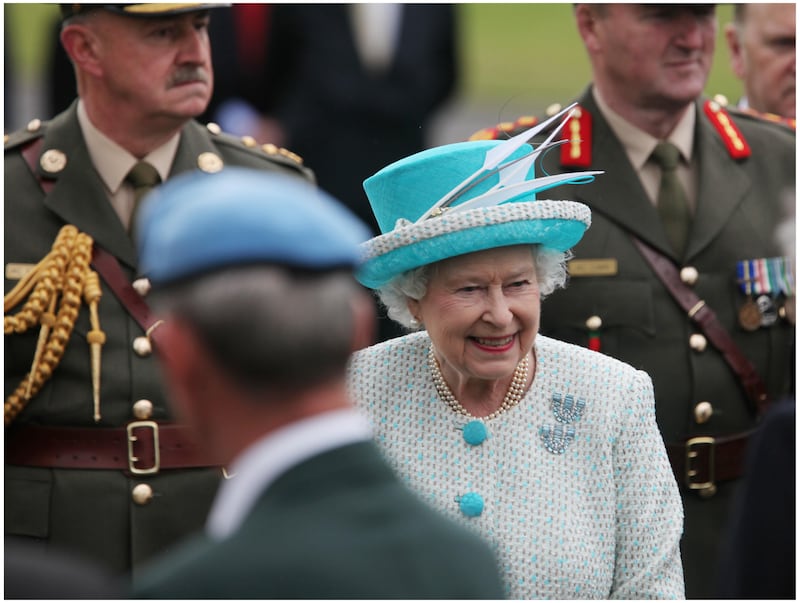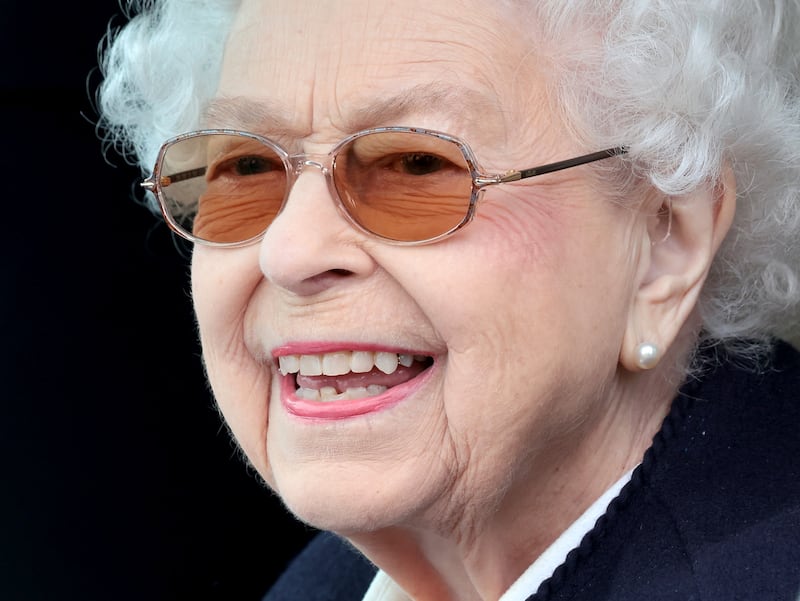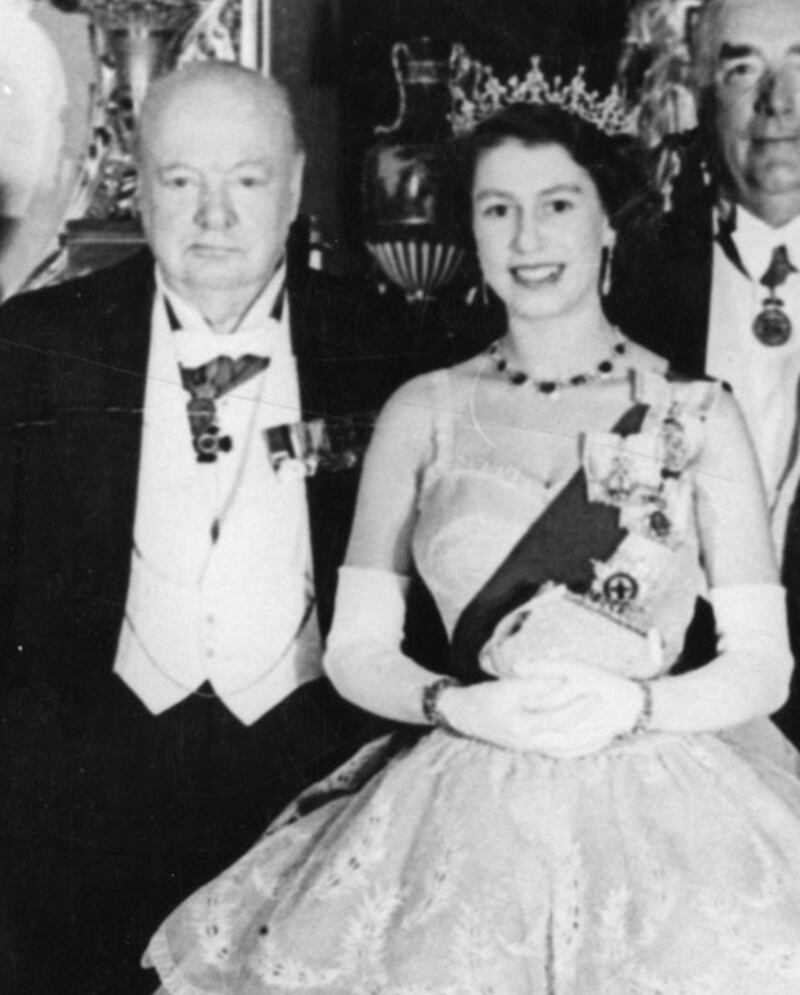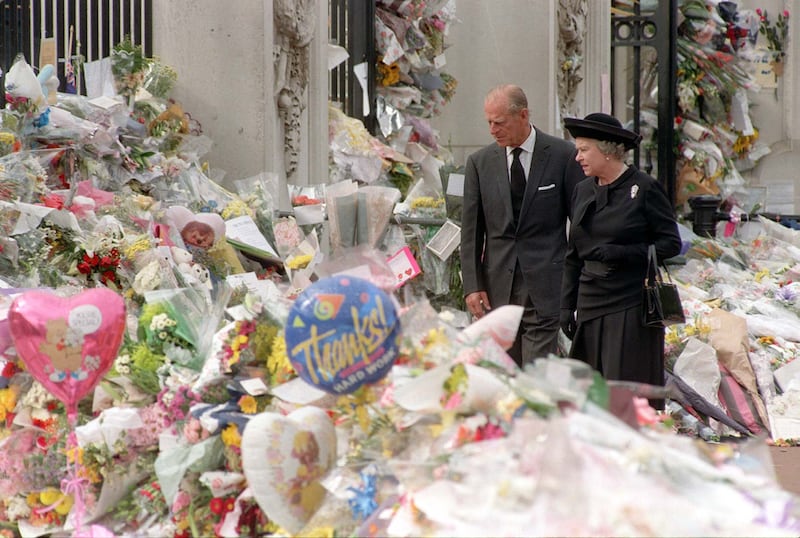She was thrifty, served herself breakfast cereal out of Tupperware (or straight from the box by Nancy Reagan’s account), read the Daily Mail, enjoyed soap operas. She loved her sturdy little Welsh corgis and was most at ease with horses. With rare exceptions, she spent a lifetime saying nothing remotely interesting aloud, yet stepping out hundreds of times a year to greet her bedazzled subjects, a small woman of 5ft 4in in sturdy sensible shoes, dressed in her signature pastel coats and small-brimmed hats chosen so they could spot her in a crowd.
“I have to be seen to be believed,” she told aides.
She was the anti-celebrity with global star power.
Amid the superlative choreography of her State visit to Ireland in 2011 weighted by centuries of bloody imperial history, more than half a million people tuned in to watch the 85-year-old planting a tree in Áras an Uachtaráin. For the State banquet, she wore a white silk dress adorned with 2,091 hand-sewn shamrocks and spoke delicately of “things which . . . we would wish had been done differently, or not at all”.
Letters to the Editor, December 13th: On queuing for food, rural Ireland and Christmas in Dublin
Leo Varadkar is right: basic maths should not flummox a minister or any of us
In a new Dáil once again dominated by men, three women could lead the Opposition
Anyone paying attention to Simon Harris could have predicted the outburst in a supermarket

How will the UK cope with losing Queen Elizabeth II?
Reporting from the Garden of Remembrance on her deeply symbolic bow to our fallen rebels, I wondered whether any heir of hers could have carried the same emotional charge. It could only have been her.
A symbol of British continuity for seven decades, in almost every day of her reign she sat down and worked her way through thick files of official papers, making her privy to all the secrets of the British state, every perfidious, violent or noble act of the services, every scalding or tedious detail of crumbling empire and Brexit. In Whitehall they called her Reader Number One according to Andrew Marr, the BBC journalist and author of The Diamond Queen.
She had weekly meetings with 14 successive prime ministers beginning with Winston Churchill and was a star diplomatic attraction for global heads of state. Armies and fleets were sent to war in her name.
It could only have been her in the Garden of Remembrance. Only she could have credibly used that phrase in Dublin Castle about “being able to bow to the past, but not be bound by it”.

She was the best-known of that stoic generation that lived through the Blitz and had played her part as an army driver and mechanic. At the age of 25, the lack of a male sibling saw her accede to the throne and with it the putative power to wage war, sign treaties, dissolve parliament, appoint a prime minister and much else. Yet the sketchiness of all that power was captured by the Victorian constitutional authority, Walter Bagehot, when he wrote that “the greatest wisdom of a constitutional king would show itself in well-considered inaction”.
She embodied that definition. What she offered in her weekly audiences with prime ministers was “a kind of higher therapy”, a space for them to share worries or explanations that would never leak, with someone who had seen it all before and worse, according to Marr. One of them noted that she always asked the question they least wanted to hear.
She certainly had views. Addressing a group of economists shortly after the 2008 economic crash, she asked the pertinent question: “Why did no one see it coming?”
[ Diarmaid Ferriter: Queen Elizabeth saw the ups and downs of Anglo-Irish relationsOpens in new window ]
[ Queen Elizabeth’s death is an earthquake for Northern Irish unionistsOpens in new window ]
[ Cork remembers laughing Queen Elizabeth with fondnessOpens in new window ]
[ Queen Elizabeth obituary: A diligent ruler who helped thaw Anglo-Irish relationsOpens in new window ]
In advance of Cop26 in Glasgow, she was overheard commenting about world leaders who wouldn’t commit to attending, saying she was “irritated” by people who “talk but don’t do”.
And yet though she was their head of state for generations, people had no idea what went on in her mind. The idea of her, the longevity, the assurance of “well-considered inaction” itself became profoundly embedded in their imaginations and consciousness. Only her most elderly subjects remember when she was not on the stamps or the currency. She was Britain’s first television celebrity, mainly because many first television sets were bought to watch her 1953 coronation. And though one of the world’s most famous cameos, she was probably the person about whom the world knew the least.
What people “knew” of her was mainly through the doughty portrayal by Helen Mirren in The Queen, or the depiction of a young, ill-prepared Lilibet developing into the inscrutable persona of Elizabeth Regina, “a strange hybrid creature, like a sphinx” as her screen husband put it in The Crown, the Netflix blockbuster guaranteed to drive royal experts and unnamed “friends” of Charles into paroxysms. It amounted to “trolling on a Hollywood budget” they raged as they hammered out fact checks to general indifference.
But with that world-beating budget, the full-sized Buckingham Palace replica, rampaging elephant, extravagant costumes and massive ratings, the series only proved yet again that the absurdist British royal soap opera fired with era-jumping themes of duty, jealousy, glamour, sex and betrayal was a world-beating brand with a living Elizabeth still at the helm.
From her marriage to the dashing, proud young naval officer Philip and her sudden accession at only 25, to the heavy hints of resentment as his character protested that kneeling before her at her coronation would “feel like a eunuch, an amoeba . . . kneeling before his wife”, the Netflix version seemed to foreshadow an entire era of social upheaval. The queen-character answered that she was his wife and his queen; a strong man, she said, would be able to kneel before both. Which if true would make her an early feminist to reckon with. She was certainly the breadwinner (if one manages to overlook the hereditary aspect), she knew her way around a car engine, she insisted on driving a Saudi crown prince around Balmoral when Saudi women were forbidden to drive and she was confident of her rank.

The one thing we can be sure of however, is that none of these insights came from the lips of the woman herself. She was Britain’s most famous enigma. Crucial to her enduring popularity and mystique was the fact that she never gave an interview. An anodyne 1969 film, Royal Family, which showed her barbecuing and chatting with the family was deemed embarrassing a year on and never shown in full again. A further television experiment in 1987 with It’s a Royal Knockout was a branding disaster.
She kept her thoughts to herself for the most part, a blank slate onto which her people could project the lost values, dreams and notions of patriotism, nationhood and nostalgia for the old England and Britannia of their imagination.
And she never changed. She remained an “old-fashioned, dutiful, pretty serious, rather solemn person . . . with those 1940s buttoned-up values that have become rather unfashionable”; the kind of person who didn’t believe “in wearing her heart on her sleeve”, as Marr described her on her diamond jubilee in 2012. The implied rebuke to younger royals was deliberate.
The view resonated with older generations as each fresh royal scandal exploded, each break for freedom by a maddened, rogue daughter-in-law or granddaughter-in-law who had bought into the fairytale marriage, the prince and the palaces but had failed to register the old-fashioned self-effacement that Elizabeth embodied. “She grew up during the war when people had to show emotional restraint. Not like today when you have to let everything out,” said political scientist Prof Vernon Bogdanor.
[ Britain’s new king describes death of Queen Elizabeth as the ‘greatest sadness’Opens in new window ]
Her boundless blandness may have been a form of “human bondage”, as cultural commentator Peter York once put it, but Elizabeth had long intuited it as the core requirement for the job, as well as attitude that symbols are better off keeping quiet. “Have you come far?” became her go-to public small talk for a reason.
Her dutiful, pedestrian speeches always had a touch of the “priggish schoolgirl” about them, as one Lord Altrincham was reckless enough to put it as far back as 1957. “She is never – you know – not the queen”, an unnamed friend told Marr. There was no point in trying to peel away outer layers expecting to find a “glittery, exciting . . . inner queen”.
That was because any understanding of her had to centre on her sense of the monarchy as a religious vocation as well as a political one. She believed she had been called by God to be queen on behalf of the British people and was therefore sacrificing herself in the manner of a nun or a priest. The monarch’s job specification includes being head of the Church of England but Elizabeth also happened to be deeply religious.

At 21, she had promised in a broadcast: “My whole life, whether it be long or short, shall be devoted to your service.” In an age when even popes retire, a monarch in her 90s would have been excused from a youthful vow. She was never going to renounce what she perceived as a sacred calling.
Though barely credible in the 2020s, the concept would have been appreciated by her subjects in 1953. Britain was still emerging from the war years, steeped in the ethos of duty, faith, sacrifice. Empire Day was celebrated annually. British schoolboys could still buy the Empire Youth Annual. A man invited to a royal garden party could bring a companion only if he was married to her.
While still a princess of barely 20 settling into a love marriage and motherhood amid retinues of servants and great wealth, Elizabeth had addressed a Mothers’ Union gathering, complaining about “the current age of growing indulgence, of hardening materialism, of falling standards” and the suffering caused by broken marriages: “We can have no doubt divorce and separation are responsible for some of the darkest evils in our society today.”
A few decades later, she watched as her only sister divorced and in 1992, the collapse of three of her four children’s marriages, two of them in spectacular fashion as a book based on Diana’s sensational revelations was published and pictures emerged of Andrew’s wife, Sarah Ferguson, having her toes sucked by a lover.
Elizabeth’s unusually sharp-toothed speech near the end of what she called her annus horribilis wondered how future generations would judge those “events”. “I dare say that history will take a slightly more moderate view than that of some contemporary commentators. Distance . . . can lend an extra dimension to judgment, giving it a leavening of moderation and compassion – even of wisdom – that is sometimes lacking in the reactions of those whose task it is in life to offer instant opinions on all things great and small . . . He who has never failed to reach perfection has a right to be the harshest critic.”
Nearly 30 years on, it still stands as a lesson if a self-serving one, in judgmentalism, perspective and hot takes.
Yet to come, in 1997, was Diana’s death in a car with a drink-driver at the wheel being chased by paparazzi through a Parisian underpass. As a witness to the angry, sobbing crowds outside Buckingham Palace roaring for the Sovereign’s flag to be lowered and for the queen to appear among them to “Show Us You Care” as the tabloid headlines put it, I would have advised her to start packing for exile. Only by acquiring more Dianas went the popular narrative, could this monarchy survive.

Who knows if Elizabeth feared for the throne. But she relented (as she had before when crowds and commentators demanded that she pay income tax). The flag was lowered and she returned. As happened throughout her reign, her monarchy’s popularity was only temporarily dented.
The year 2019 was even more of an annus horribilis, arguably. Her grandsons William and Harry fell out. Viciously hostile stories in the British press about Harry and his American, mixed-race wife, Meghan, culminated in the pair taking legal action against a number of tabloids and eventually departing for the US. But by far the most grave and most enduring damage was inflicted by Andrew’s disastrous BBC Two interview about his links to the convicted sex offender Jeffrey Epstein and allegations of sex with a 17-year-old girl.
That same year the powerlessness of the monarchy was mercilessly exposed when Westminster heavies led by Jacob Rees-Mogg flew to Balmoral in August 2019 to demand that the queen prorogue parliament. Whatever her views, it became clear that she had no choice. What was she for, people asked?
Her filmed speech for Cop26 (which illness kept her from attending) was notable for its touching references to her “dear late husband” and how his environmental interests lived on through the work of Charles and his eldest son. See the big picture, she was saying: “None of us will live forever.” A cynic might describe it as a rebranding effort but it felt like a valedictory.
As the kebab-seller in Mike Bartlett’s play King Charles III observed: “The Queen’s dead. If you take enough layers away, what have you got left, underneath, know what I mean? Maybe she was what held it together.”




